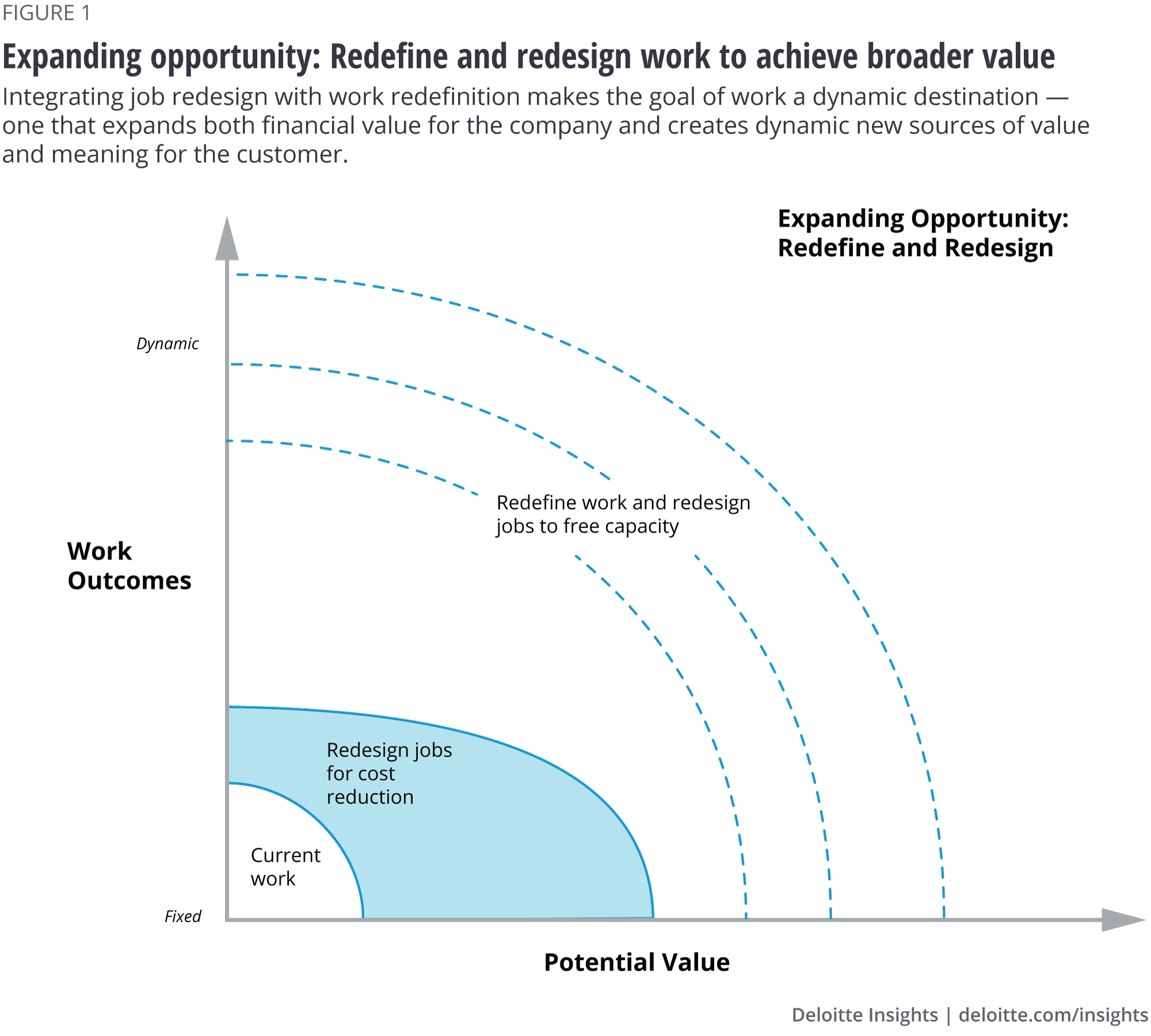
Redefining work for new value The next opportunity
11 minute read
05 December 2019
Redesigning jobs should be viewed not as an end goal but as a process that enables work itself to be redefined so that the workforce creates new value.
This article was originally published by MIT Sloan Management Review.
The nature of work is evolving in two complementary directions. In one direction, managers are redesigning jobs to take advantage of new opportunities to automate workflow processes. Their aim: transform how workers execute tasks in order to boost efficiencies and reduce costs. At the same time, some managers are redefining work to take advantage of new capacity freed up by job redesign. With work redefinition, work is becoming no longer simply about task execution; it’s about creating new sources of value for customers and the business. Although redesigning jobs and redefining work are both typically integral to long-term strategy, our research shows that too many companies are focused primarily on the former. Without an overriding strategy of redefining work, workers represent cost savings rather than freed capacity to create new value for the business or the customer.
Learn more
Explore the Future of Work collection
Subscribe to receive related content from Deloitte Insights
Download the Deloitte Insights and Dow Jones app
This can be a big problem: Investing in job redesign without first planning for and investing in redefining work can narrow future outcomes and limit opportunities for both growth and long-term value creation. Understanding the relationship between these two approaches to work is essential to any strategic effort to compete over the long term.
Of the two approaches, job redesign is clearly the more popular and well understood. The rationale is often cost reduction—either directly, by reducing head count, or indirectly, by eliminating human-driven mistakes and delays. Job redesign may benefit customers with quicker response times, more consistent or error-free service, or lower costs, but cost reductions generally are a game of diminishing returns over time.
The less familiar but more expansive approach is to redefine what work is all about: It shifts the primary objective of work from efficiency to broader value creation. When work is appropriately redefined, workers focus on identifying and addressing unseen problems and opportunities instead of executing tasks. In contrast to the incremental and diminishing returns of job redesign, redefining work leads to increasing returns because of its significant potential for long-term value creation.
Pursued together, these two approaches are complements. Redesigning jobs should be viewed not as an end goal, but as a process that enables work itself to be redefined so that the workforce creates new value. The challenge for management is to orchestrate initiatives that unite job redesign and work redefinition for that greater opportunity.
What is the opportunity?
Without an overriding strategy of redefining work, workers represent cost savings rather than freed capacity to create new value for the business or the customer.
Companies won’t be able to significantly improve value creation if they redesign jobs to optimize processes with the goal of reducing costs. (Figure 1.) All workforce initiatives should answer the question, “How does this enable us to identify and create new sources of value and meaning for our customers over time?”
“Without an overriding strategy of redefining work, workers represent cost savings rather than freed capacity to create new value for the business or the customer.”
For instance, when a regional bank transitioned to new productivity software, it enlisted volunteers from across the company to not just train their peers on the new tools, but also to help them redesign their own work. They looked for opportunities to automate or eliminate tasks rather than just transfer every current task and report into a new system. Employees were encouraged to question what work needed to be done based on how they were delivering value to the customer.
As a result, people across the bank streamlined, simplified, automated, and jettisoned their old tasks, thus freeing up capacity that enabled them to focus more on getting to know what their customers (often internal) needed or might need in the future. The volunteer trainers benefited from an intensive experience that developed their creativity, empathy, curiosity, and other capabilities, but the entire workforce gained an understanding that they had the ability and expectation to redefine their work to better serve customers. The financial analyst’s objective, for example, was not to generate a report, but to get data into the hands of the underwriter to make sure that the local feed-and-seed store got the right credit product for the winter slump. The learning specialist’s work was not to roll out three training modules, but to better enable staff members at 20 branches to build deeper relationships with customers and get better at identifying and addressing opportunities that would further the bank’s strategy. That might mean doing role-plays with one manager, connecting sales reps with mentors in another branch, or providing tablets to loan officers.
Integrating job redesign with work redefinition makes the goal of work a dynamic destination—one that expands both financial value for the company and creates dynamic new sources of value and meaning for the customer. That’s represented by the dotted lines in figure 1.

The workforce challenge for most companies is to make the transition from fixed work outcomes that deliver limited value to dynamic work outcomes with higher levels of potential value. A major part of this shift is to recognize that virtually all workers at every level of the organization, aided by machines, have the ability to anticipate what customers really want or need and to develop new approaches to meet those needs. Instead of merely executing routine tasks and predefined processes, the work of the front line becomes identifying and addressing unseen problems and opportunities. Given these workers’ proximity to the customer, they are well positioned to develop and tinker with new approaches, and to learn how to better create value for the customer.
To be clear, at the companies that inspired us, the leaders weren’t saying, “Oh, here will be a ‘redesign job’ initiative,” and, “This will be our ‘redefine work’ initiative.” They were saying, “Look, we know there are some technologies that can do a lot of what our front line is doing. We know we need to modernize some pieces of our infrastructure (a call center management system or new regulations), and also, we’re feeling pressure that we need to find new ways to compete or we’re going to be out of business, and our workforce doesn’t look ready to take us there.” In each case, the companies recognized two things: first, that sustainable growth depends on creating more value for the customer; and second, that their workforce was a significant asset worth investing in. As a result, most initiatives did double duty, in some way offering development opportunities for parts of the workforce as part of redesigning or redefining work.
How to break out of the efficiency trap
Many companies engaged in redesigning jobs today are caught in a kind of efficiency trap that can prevent managers from realizing, or even pursuing, the potential of redefining work. To understand the scale and scope of this issue, executives need to embrace the fact that they are in the midst of a shift from scalable efficiency, where value creation in steady-state business environments focuses on optimization and predictability, to a future state of scalable learning, where conditions and requirements change rapidly and value creation focuses on learning and adaptation.
In companies that primarily focus on job redesign, the very front-line workers needed to identify and address new opportunities are let go or are retrained into similarly routine activities in a completely different part of the organization.
“In companies that primarily focus on job redesign, the very front-line workers needed to identify and address new opportunities are let go or are retrained into similarly routine activities in a completely different part of the organization.”
In this shift, the workforce becomes key to value creation. While this is a familiar refrain, it is not the way most companies approach their current and future work and workforces, judging from where they choose to (or choose not to) develop initiatives and invest resources and attention. Many companies continue to see their workforce as resources to be managed, controlled, and mechanized. (We have spent the past 100-plus years exploiting models of Frederick Taylor’s ideas of scientific management.)
To overcome the obstacles—of short-term cost optimization, Taylorism, and a single-minded focus on automation—leaders should first develop a compelling longer-term vision of the opportunity. This vision should guide a set of near-term initiatives that free up workforce capacity and enable work to be redefined:
- Zoom out to develop a sense of what the unmet needs of the marketplace might be, what types of impact might be most valuable, and what the most meaningful metrics will be. This zoomed-out vision can help make clear how today’s tasks won’t meet those needs and also provide guidance about where managers and those on the front line should focus their day-to-day efforts. Zooming out highlights two essential challenges for business leaders. The first challenge is setting a clear direction that articulates where the company is heading and how it will create growth and value. Unfortunately, today the primary—and, in some cases, only—message workforces are hearing is the importance of lowering costs and error rates. Where is the direction and message about value, impact, and meaning? The second challenge is to provide support incentives for workers to focus on value and growth. This includes providing incentives for solving new problems and acquiring new, relevant skills.
- Redesign jobs to free up capacity for redefined work. Use automation or other technologies and workforce alternatives to perform rote work that prevents the workforce from spending more time on better understanding and addressing customer needs. Direct redesign and automation efforts at parts of the business where redefining work has the potential to achieve significant impact quickly—for example, where an operational pain point has persisted in the status quo. Commit, and communicate, to the workers that they will be retained in the same areas with a charter to make a difference in achieving the zoomed-out vision. Rather than reskilling workers for other routine tasks, consider forming them into work groups and engaging them in the problem-solving activities needed to automate and redesign their work in order to begin preparing them for redefined work.
- Redefine work in targeted areas of the organization. By focusing on a small set of work groups where capacity has been created and where a meaningful impact is likely, you can create momentum, support, and the organizational capacity to redefine work more broadly. The goal is to move fast and lay the groundwork to support breaking from the status quo and meaningfully refocusing on value creation without getting bogged down. These supports include setting new expectations for the front line and helping front-line supervisors adopt a new role in which they coach and guide their workgroups. To accomplish this, leaders must provide clarity about the areas of impact that matter most, and front-line managers must translate that guidance into effective direction and motivation for their work groups. Those work groups can then begin taking action and developing new practices that will help them become more effective in this work.
Orchestrating all three initiatives requires a significant amount of leadership. In a complex and fast-moving business environment, managers and workers need more than detailed scripts and instructions. They need a clear sense of direction along with the tools and expectations to explore new directions. Perhaps most important, leaders should ensure that the initiatives are developing and engaging a workforce with the capabilities and motivation to continuously learn and adapt.
In the earlier example of the regional bank, leadership envisioned securing customers with helpful, highly personalized products that would evolve with the customer, and they communicated this customer-centric vision. While launching technology initiatives, leaders made clear that the redesign was intended not to reduce head count but rather to reduce workload so the workforce could focus on better serving individual customers. Then management shifted workers toward redefined work by engaging them in deciding how best to use new tools to do the work of serving the customer or supporting those who do.
Each initiative has to meaningfully connect back to what it is in service to: creating the space and capacity for the workforce to perform the activities that lead to the creation of new value. And that, not cost reduction, is what the leader should ruthlessly focus on. The leader will have to remind individual managers and other leaders about where they are going and what they are in service to in order to discourage each group from focusing on its own narrow objectives at the expense of the broader goal. They must bring to bear the available management resources and investments, pulling from across functional silos and connecting and arranging them to achieve a coherent whole—a much greater objective for the company.
Investing in opportunity: Increasing versus diminishing returns
Leaders should ask, “As technology frees us to do different work, what are the mindsets, tools, and capabilities we need in order to embrace the value that humans can bring to work, and what types of investment does the organization need to make to support that?”
It’s about investing in developing the workforce and creating a work environment—which includes the physical and virtual spaces, as well as the management systems and practices—that encourages (and requires) front-line workers to use their human capabilities to find new sources of value. It also includes investing in the technologies that can free up workers’ capacity.
The most important investment often is not in training or reskilling, but in opportunity. Companies should create opportunities for workers at all levels to deepen their capabilities, skills, and motivation in order to learn how to make a meaningful impact on the customer, company, or community. Where there is a real need for specific hard skills, the same capabilities and motivation will help workers find the training they need, when and how they need it, and adapt both new and old skills to address whatever current challenges they face. Given the variety of formats and modalities available, the investment in skills training is primarily about ensuring that front-line workers have access to a range of quality options that meet their current needs and also help them prepare for future roles. The bigger gap—where companies need to invest—is in ensuring that workers have clear opportunities to use, develop, and adapt their new skills, tools, and techniques, and to develop the capabilities to keep learning and adapting as conditions change.
Based on our research, the most effective companies prioritize learning, broadly defined, by investing in resources and incentives, and, often, by accepting a different level of risk or risk profile. They often invest managerial time in coaching, setting expectations, and providing support to help leaders and line managers alike coach their teams. These investments tend to generate quick and tangible returns in terms of value delivered, in part because they focus on the small moves that build credibility and deliver the most impact while the organization is learning what will be required to scale the efforts more broadly. Taking a “small moves, quick impact” approach is one benefit of having a clear focus on the metrics that matter.
These companies made the investment because they recognized that the way they had been working would not be sufficient for the future. The future of work will require a new focus on the orchestration of cost and value as well as redesigning jobs and redefining work. Workers, customers, managers, shareholders, and society are looking for business leaders to embrace and drive the goals of cost, value, impact, and meaning—together.
© 2021. See Terms of Use for more information.
Read more on Future of Work
-
The digital-ready worker Article5 years ago
-
The future of work in manufacturing Article5 years ago
-
What is the future of work? Article6 years ago
-
From jobs to superjobs Article6 years ago
-
A pragmatic pathway for redefining work Article5 years ago
-
Fighting for the future Article5 years ago
















